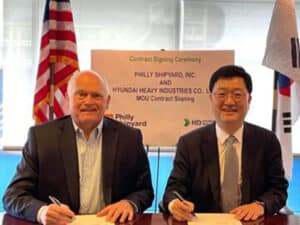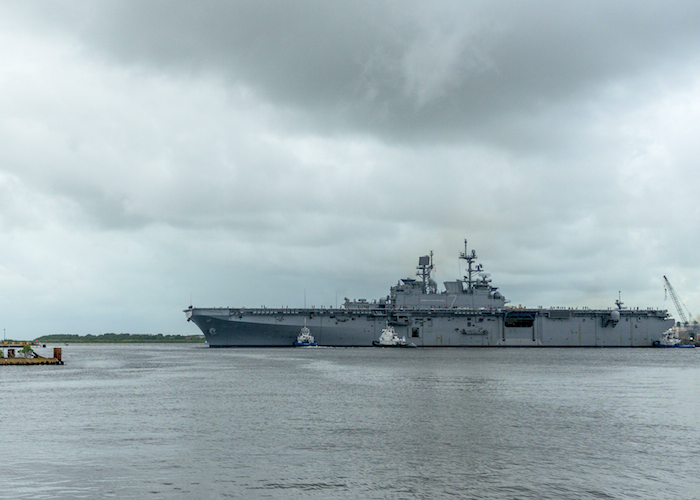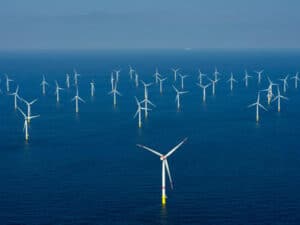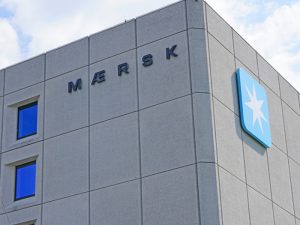
Defense rethink could mean big changes for shipbuilders
Written by Nick Blenkey
The Navy’s newest amphibious assault ship, USS Tripoli (LHA 7), departed from Ingalls Shipbuilding division last month, sailing to its homeport in San Diego. Tripoli enters the Pascagoula River channel passing guided missile destroyer Delbert D. Black (DDG 119), which has been delivered to the Navy by Ingalls, and will sail away later this year. [Credit: Lance Davis/HII]
Big Changes Ahead?
Unmanned surface vessels are something that need keeping under scrutiny because they underscore that the Navy of the not so distant future may look a lot different.
A Congressional Research Service Report “Navy Force Structure and Shipbuilding Plans: Background and Issues for Congress” released June 3 spells out some of what’s already in play.
Right now, the Navy is mandated to achieving and maintaining a fleet of 355 ships of certain types and numbers. The Navy’s 355-ship force-level goal is the result of a Force Structure Assessment (FSA) conducted by the Navy in 2016.
According to the CRS report, a new FSA, referred to as the Integrated Naval FSA (INFSA), was expected to be published sometime during the spring of 2020.
“Statements from Department of the Navy (DON) officials suggest that the INFSA could result in a once-in-a-generation change in the Navy’s fleet architecture, meaning the mix of ships that make up the Navy,” says the CRS report. “DON officials suggest that the INFSA could shift the fleet to a more distributed architecture that includes a reduced proportion of larger ships, an increased proportion of smaller ships, and a newly created category of large unmanned surface vehicles (USVs) and large unmanned underwater vehicles (UUVs). Such a change in fleet architecture could alter the mix of ships to be procured for the Navy and the distribution of Navy shipbuilding work among the nation’s shipyards.”
The CRS report says that statements from Navy officials in the early months of 2020 suggested that the INFSA could result in a new Navy force-level goal for a fleet of about 390 manned ships plus about 45 unmanned or optionally manned ships, for a total of about 435 manned and unmanned or optionally manned ships.
However, the CRS report notes that the INFSA has been delayed repeatedly and that recent reports are that Secretary of Defense Mark Esper and the Cost Assessment and Program Evaluation (CAPE) office within the Office of the Secretary of Defense (OSD) have been reviewing the INFSA and conducting their own analysis of future Navy force structure requirements, and that the INFSA will not be released until OSD completes its review and analysis. OSD’s study of future Navy force-level requirements reportedly recommends a fleet with, among other things, 68 or 69 nuclear-powered attack submarines (SSNs), nine aircraft carriers, 80 to 90 large surface combatants (i.e., cruisers and destroyers), 55 to 70 small surface combatants (i.e., frigates and Littoral Combat Ships [LCSs]), 65 unmanned or lightly manned surface vehicles, and 50 extra-large unmanned underwater vehicles (XLUUVs).
At this stage of the game, any significant action to implement the INFSA will have to wait for the next budgetary cycle in 2021 and analysts fear that that the huge bills incurred in response to the COVID-19 pandemic will mean big reductions in defense budgets.
Shipbuilding Industrial Base
The report accompanying the Senate version of the NDAA says that the bill “reshapes the Defense Industrial Base as a more resilient, advanced National Security Innovation Base. The COVID-19 pandemic exposed and exacerbated supply chain deficiencies across the government, and the FY21 NDAA takes numerous steps to secure the supply chain—both from overreliance on foreign nations and from infiltration by our adversaries.”
This could have very significant implications going forward, not least in increasing the requirements for U.S. content in ships.
Under the heading “Domestic Manufacturing Requirements for Navy Shipbuilding,” the report accompanying the House version of the NDAA says, “The Committee consistently has expressed its concern with the Department of the Navy sourcing surface ship components from foreign industry partners rather than promoting a robust domestic industrial base. To address these concerns, the Committee retains several provisions from fiscal year 2020 and a new provision that expands the domestic manufacturing requirement for several classes of ships under development. Absent stringent contract requirements in these future surface ship classes, the Committee lacks confidence that the Navy will make the necessary decisions and provide the required resources to support a robust domestic industrial base.”
That drew strong support from the American Shipbuilding Suppliers Association (ASSA), which notes that the House legislation would include language in the 2021 defense authorization bill directing that major defense acquisition programs “shall be deemed to be manufactured substantially all from materials and components produced, or manufactured in the United States.” The current statutes describe “substantially all” as 50%—the new provision would increase that to 75% in October 2021 and then to 100% by 2026.
By law, U.S. Navy ships are required to be built in U.S. shipyards. However, says ASSA, “there is no such requirement for critical Hull, Mechanical & Electrical components—propulsion systems, machinery control systems, shafts, bearings, ships service power generation and many others—to be manufactured in the U.S.”
“ASSA wants a seat at the table early on when the Navy is designing the ships so they can be ready with the components required as a reliable, ever present, domestic source for U.S. shipyards,” said George Williams, CEO of ASSA. “Instead, these decisions are relegated to shipyard primes or their foreign-owned partners, and there is no requirement for sourcing these components within the U.S. shipbuilding supplier industrial base.”




